With impressive growth over the last 30 years since the launch of its reform and open-door policies, China is emerging as a global economic power. It is now expected to pass Japan in GDP terms as early as 2010, and the day when it overtakes the United States to become the world's largest economy is approaching.
China has become a global economic power
The average annual rate of GDP growth for the period from 1979, which marked the launch of the reform and open-door policies, to 2008 was 9.8%. China has a population of 1.3 billion, and it is unprecedented in the human history for such a large country to maintain growth that high over such a long time. In fact, the economic growth rate of China over the last 30 years not only substantially exceeds Japan's 2.4% for the same period, it is also higher than the average annual rate of 9.3% that Japan achieved during its 18-year economic "miracle" period from 1956 to 1973. The period over which China has achieved rapid growth is also longer than it was in Japan ( figure 1 ).
Figure1: Comparison of High-Growth Periods of China and Japan
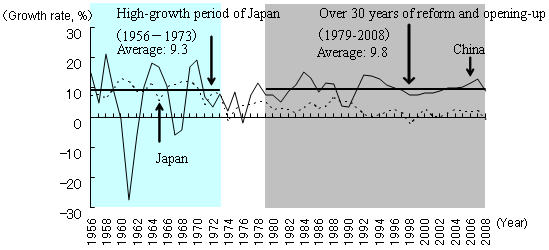
(Source) For statistical data of China, the Comprehensive Statistical Data and Materials on 50 Years of New China of the National Bureau of Statistics of China are used to 1978, and various issues of the China Statistical Abstract is used after 1978. For statistical data of Japan, statistics of the Cabinet Office are used.
The latest economic crisis has adversely affected not only the United States, the epicenter of the global financial meltdown, but also developed regions such as the European Union (EU) and Japan. The Chinese economy, on the other hand, is looking like the sole winner. According to the World Economic Outlook published in October 2009 by the International Monetary Fund (IMF), the Chinese growth rate is expected to be 8.5% in 2009, the highest among the G20 countries and regions ( figure 2 ). As China has survived the global financial crisis and succeeded in maintaining high growth, its place as a global economic power is now firmly established.
Figure 2: Economic Growth Rates of G20 members in 2009 (forecast)
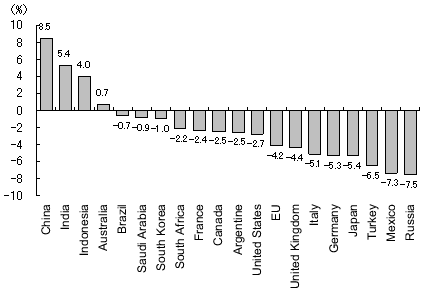
(Source) IMF, World Economic Outlook Database , October 2009
China likely to exceed Japanese GDP as early as 2010
As if to symbolize the rise of China, the day when its GDP exceeds that of Japan is approaching. In terms of global GDP rankings, China overtook Germany to become third in 2007, after the United States and Japan, rising from 10th in 1978. Chinese GDP reached 4.327 trillion dollars in 2008, accounting for 7.1% of the world total GDP, and equivalent to 88.1% of the GDP of Japan (4.911 trillion dollars, 8.1% of the world total GDP) ( figure 3a ). Even taking the recent rise in the exchange rate of the yen against the Chinese yuan into account, it is highly likely that China will pass Japan in 2010, given the substantially higher Chinese growth rate. This means that Japan will relinquish its place as the world's second largest economic power, which it has maintained since 1968 when it passed West Germany.
However, GDP is not necessarily a credible indicator as a standard for international comparisons of economic size, as GDP in dollar terms is greatly influenced by exchange rates and does not take into account the fact that the price levels of developing countries are generally lower than those of developed nations. In fact, the ratio of China's GDP to that of Japan fell from 28.9% to 12.8% (from 2.6% of the world total GDP to 1.7%) from 1980 to 1990, reflecting a fall in the yuan, despite the fact that China had been achieving high growth of approximately 10% a year since the beginning of its reforms.
To correct this bias, the IMF published GDP figures of countries around the world based on purchasing power parity (PPP), which evaluates the same goods and services at the same prices. Based on PPP, the difference between Chinese GDP and that of Japan has been steadily contracting since the reforms, and China's share of world GDP has been rising. The PPP-based GDP of China exceeded that of Japan in 2001 and reached 7.9 trillion dollars (11.4% of the world total GDP) in 2008, which was 1.8 times larger than that of Japan (4.4 trillion dollars, 6.3% of the world total GDP) ( figure 3 b ).
Figure 3: Comparison of GDPs of Japan, the United States and China
a) In dollar value
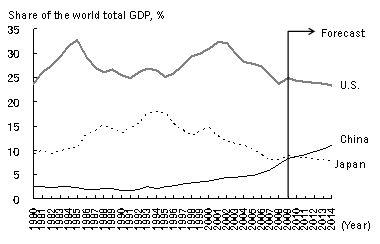
b) Based on Purchasing Power Parity (PPP)
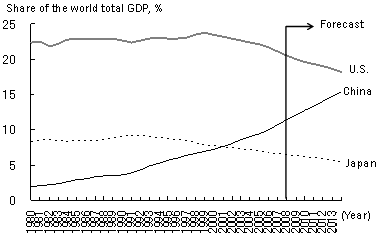
(Source) IMF, World Economic Outlook Database , October 2009 (including forecasts)
And yet, given that China's population is ten times larger than that of Japan, its per capita GDP is still only about 10% that of Japan (about 20% based on PPP) and nowhere near the world average (45% in dollar value and 68% based on PPP in 2010), even though the absolute size of GDP exceeds Japan. This means that while the living standards of Chinese people are still lower than those of developed nations, China's growth rate is anticipated to be higher over the long term if China succeeds in realizing the advantage it enjoys as a latecomer.
In 2008, Chinese GDP was about 30% of that of the United States in dollar terms (55% based on PPP). By 2030, though, China is likely to boast the world largest GDP, surpassing the United States, as it continues to maintain higher growth than that of the United States and the yuan rises against the greenback ( box ).
Box: Toward the resurrection of China
Boasting a 4000-year history, before modern times China was long the world's largest economy. According to Angus Maddison, a professor at the University of Groningen in the Netherlands who specializes in economic history, Chinese GDP (based on the 1990 international dollar, which is similar to the concept of PPP) accounted for 32.9% of total world GDP at its peak in 1820. After the Opium Wars, however, the share steadily declined to 4.6% in 1950, immediately after the founding of the People's Republic of China, and further to 4.0% in 1962 following the Great Leap Forward under Mao Tse-tung. Although the Chinese economy picked up to some extent after that, it was not until the 1980s that it rebounded in earnest, following the introduction of reform and open-door policies ( table ). This remarkable economic development in recent years is therefore not only a story of China's rise to global power but also a story of its resurrection.
Table: Long-Term Trends in Population, GDP and Per Capita GDP of China
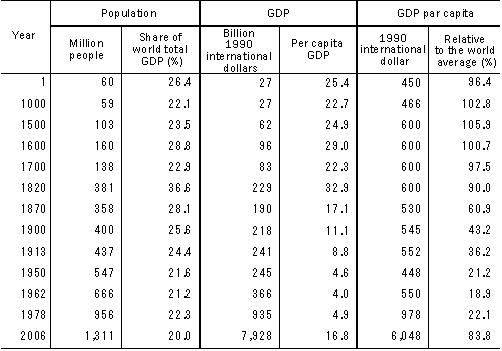
(Note) GDP is based on the 1990 international dollar, taking PPP into account
(Source) Angus Maddison, "Statistics on World Population, GDP and Per Capita GDP, 1-2006 AD" (March 2009), http://www.ggdc.net/maddison/


